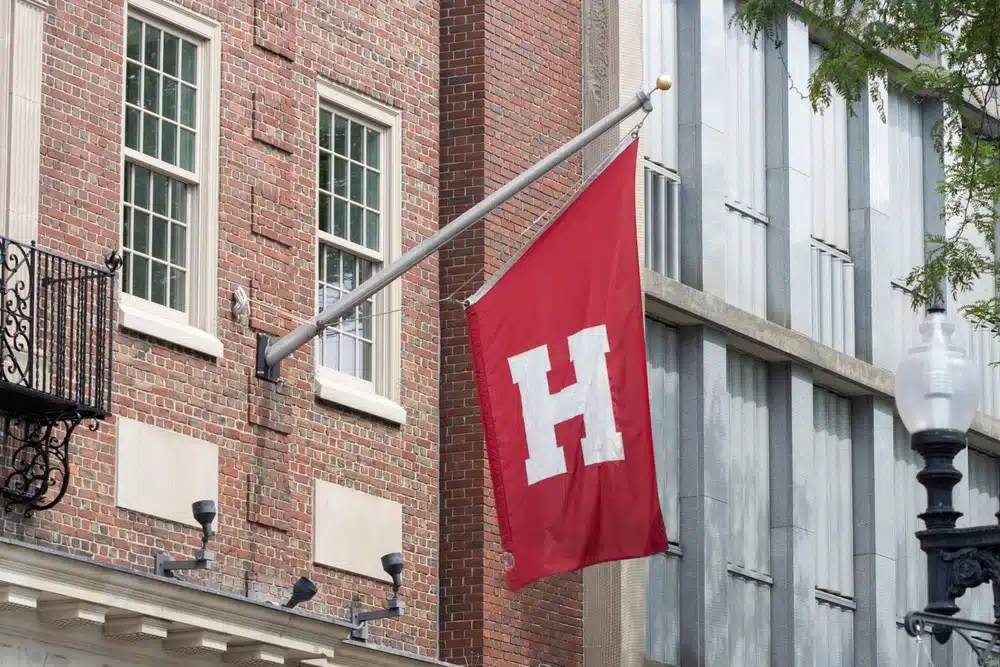Exploring Harvard Enrollment Trends
Harvard University, since its inception in 1636, has always been one of the world’s leading higher-education institutions. It is renowned not only for its academic excellence but also for the intriguing trends and patterns observed in its enrollment process. This article aims to explore these trends, providing insight into Harvard’s enrollment process, historical overview, demographic breakdown, impact of policies, and future predictions.
Understanding Harvard’s Enrollment Process
The admission process at Harvard is holistic and evaluates applicants based on a multitude of factors. Central to this process is a deep understanding of each student’s individual interests, potential growth, and personal circumstances.
Harvard’s enrollment process is designed to identify and admit students who not only excel academically but also possess a diverse range of talents, skills, and experiences. The university seeks individuals who will contribute meaningfully to the Harvard community and make a positive impact on the world.
The Role of Admissions in Enrollment
The Admissions Office at Harvard serves as the gateway to prospective students. Their role extends beyond merely determining eligibility based on grades. They conduct thorough assessments to identify promising candidates who can contribute significantly to the diverse Harvard community.
Admissions officers carefully review each application, taking into account various factors such as academic achievements, extracurricular involvement, leadership potential, and personal qualities. They seek to understand the unique strengths and passions of each applicant, looking beyond the numbers to gain a comprehensive view of their potential.
In addition to evaluating academic qualifications, the Admissions Office also considers a student’s personal circumstances and background. They understand that not all students have had the same opportunities, and they strive to create a diverse and inclusive student body that represents a wide range of experiences and perspectives.
Furthermore, the Admissions Office collaborates with other departments to ensure that students who show potential but may require financial aid or additional support are adequately assisted. Harvard is committed to providing access to education for all qualified students, regardless of their financial circumstances.
Key Factors in Harvard’s Enrollment Decisions
Harvard looks beyond academic records when making enrollment decisions. Inherent skills, leadership potential, and commitment to community service are among the additional factors considered. The university values students who have demonstrated a dedication to making a positive impact in their communities and have shown leadership abilities.
Significant weight is also placed on personal essays and recommendation letters, which provide nuanced perspectives about a candidate. These documents offer insights into an applicant’s character, values, and aspirations, allowing the Admissions Office to better understand the individual behind the application.
Another influential factor is a student’s demonstrated interest. While Harvard does not officially consider “demonstrated interest,” applicants can make their penchant for the Ivy League institution evident through campus visits, engaging in informational interviews, and their application narrative. These interactions can demonstrate a genuine desire to be a part of the Harvard community and contribute to its vibrant intellectual and social life.
Harvard’s enrollment process is a comprehensive and thoughtful evaluation of each applicant, taking into account their unique qualities, experiences, and potential. The university seeks to admit students who will thrive academically, contribute meaningfully to the campus community, and go on to make a positive impact in the world.
Historical Overview of Harvard’s Enrollment
An investigation of the historical trends in Harvard’s enrollment sheds light on the university’s growth and diversification efforts.
Enrollment Trends in the 20th Century
The 20th century saw exceptional growth in Harvard’s enrollment. This, in part, can be attributed to increased access to secondary education and vocational training in America, leading to an uptick in eligible applicants. As the nation’s educational landscape expanded, so did the pool of talented students seeking admission to prestigious universities like Harvard.
Furthermore, generous endowments and scholarships played a pivotal role in opening the Harvard gates to students without the financial means. These initiatives aimed to ensure that deserving students from all walks of life could pursue their academic dreams at Harvard, regardless of their socioeconomic background.
Notably, the latter half of the 20th century saw important changes as Harvard began admitting women and students from diverse racial backgrounds. This move aimed to promote inclusivity and diversity within the university community. It was a calculated step to mirror the changing societal structure and represent the full gamut of the human experience. The decision to embrace diversity has enriched the academic environment at Harvard, fostering a vibrant and inclusive community.
Recent Changes in Enrollment Patterns
The 21st century brought new challenges and changes to Harvard’s enrollment trends. With advancements in digital technology, there has been a significant increase in international applications, making Harvard a truly global institution. Students from all corners of the world now have the opportunity to join the Harvard community, contributing their unique perspectives and experiences to the academic discourse.
However, the onset of the COVID-19 pandemic also brought unprecedented changes to enrollment patterns. The year 2020 witnessed a record-high deferral rate, mainly due to international travel restrictions and the shift to online-only instruction. The pandemic forced Harvard, like many other universities, to adapt quickly to remote learning and virtual interactions. Despite the challenges, the Harvard community demonstrated resilience and innovation, ensuring that students continued to receive a high-quality education even in the face of adversity.
As you look on the historical overview of Harvard‘s enrollment, it becomes evident that the university’s commitment to excellence, inclusivity, and adaptability has been instrumental in shaping its enrollment patterns. Harvard’s journey is a testament to the transformative power of education and the continuous pursuit of knowledge.
Demographic Breakdown of Harvard’s Enrollment
Further exploration of Harvard’s enrollment trends requires an understanding of the demographic breakdown of students.
Harvard University, one of the most prestigious educational institutions in the world, prides itself on its commitment to diversity and inclusivity. The university recognizes that a diverse student body fosters a vibrant intellectual community and prepares students to thrive in an increasingly interconnected world.
Gender Distribution in Enrollment
Harvard’s commitment to gender equity is reflected in its enrollment. The female-to-male ratio has been approximately equal for the past few years, representing a progressive shift from the 1960s when women were first admitted.
Today, women make up a significant portion of Harvard’s student population, excelling in various fields of study. They have shattered glass ceilings and continue to challenge societal norms, making significant contributions to academia, research, and leadership.
This shift is not limited to undergraduate students; Harvard’s graduate schools also strive to balance the scales. Despite some fields traditionally experiencing gender imbalance, concerted efforts are underway to break these barriers and ensure equal representation.
Harvard provides numerous resources and support systems to empower women and promote gender equality on campus. Women’s organizations, mentorship programs, and initiatives focused on women’s leadership have flourished, fostering an environment where all students can thrive regardless of gender.
International Students and Enrollment
International students have always been a vital part of the Harvard community. Harvard’s holistic admissions process grants equal consideration to domestic and international students, leading to a rich diversity in student backgrounds.
Harvard’s commitment to global engagement is evident in its efforts to attract and support international students. These students bring unique perspectives, cultural experiences, and global perspectives to the university, enriching the educational experience for all.
The international student population at Harvard has seen an upward trend, further diversifying its campuses and contributing to its global character. However, fluctuations in U.S. immigration policies and the recent pandemic have intermittently impacted this trend.
Despite these challenges, Harvard remains dedicated to providing a welcoming and inclusive environment for international students. The university offers comprehensive support services, including international student offices, cultural organizations, and academic resources tailored to meet the unique needs of students from around the world.
Furthermore, Harvard encourages cross-cultural exchange and dialogue through various initiatives, such as international student exchange programs, study abroad opportunities, and globally focused research projects.
By embracing diversity in all its forms, Harvard University continues to foster an environment where students from different backgrounds can come together, learn from one another, and contribute to the advancement of knowledge and understanding.
Impact of Policies on Harvard’s Enrollment
Harvard’s enrollment trends are also heavily dependent on its policies and the changing educational landscape.
Harvard University, one of the most prestigious institutions in the world, has implemented various policies that have had a significant impact on its enrollment. These policies have not only shaped the composition of the student body but have also influenced the accessibility and inclusivity of a Harvard education.
How Financial Aid Policies Influence Enrollment
Financial aid has played a significant role in democratizing student enrollment at Harvard. The university’s generous need-blind policy ensures that financial constraints are not a barrier to deserving students, thereby influencing the economic diversity in enrollment.
Under this policy, Harvard evaluates applicants based on their academic and personal achievements, without taking into consideration their ability to pay for tuition. This approach has created opportunities for students from low-income backgrounds to pursue higher education at Harvard, breaking down socio-economic barriers that may have otherwise hindered their enrollment.
Besides need-blind admissions, the university also offers a plethora of scholarships, work-study options, and loans to further assist students in financing their education. Initiatives like these have considerably increased the accessibility of Harvard education to a broader population.
Harvard’s commitment to financial aid extends beyond admission. The university is dedicated to meeting the full demonstrated need of all admitted students, ensuring that they can fully engage in the academic and extracurricular opportunities available on campus without financial burden. This comprehensive approach to financial aid has not only attracted talented students from diverse backgrounds but has also fostered a vibrant and inclusive community at Harvard.
The Effect of Early Action on Enrollment
Early action has been another game-changer in Harvard’s enrollment trends. This policy allows students to apply by November and receive a decision in mid-December, thereby relieving some of the stress related to college application and acceptance.
By offering early action, Harvard acknowledges the importance of providing students with a timely response, allowing them to plan their future accordingly. This policy has been particularly beneficial for students who are eager to secure their spot at Harvard and start planning their academic journey.
However, it’s noteworthy that the move towards early decision strategies has recently been criticized for potentially favoring more privileged students who don’t have to compare financial aid packages from numerous colleges before deciding. Critics argue that this policy may inadvertently disadvantage students from low-income backgrounds who may need to consider multiple financial aid offers before making a final decision.
Harvard recognizes the concerns surrounding early action and is committed to ensuring that the policy remains fair and equitable. The university continues to review and refine its admission processes, taking into account the potential impact on students from all socio-economic backgrounds.
In conclusion, Harvard’s enrollment is not solely influenced by its reputation and academic excellence. The university’s policies, such as need-blind admissions and early action, have played a crucial role in shaping the composition of its student body and fostering a diverse and inclusive community. By prioritizing accessibility and fairness, Harvard continues to be a leader in higher education, attracting talented students from all walks of life.
Future Predictions for Harvard’s Enrollment
Harvard’s enrollment trends are bound to evolve with the changing socio-political and technological landscape.
Projected Enrollment Trends
Harvard is likely to see an increase in international applicants, as digital platforms continue to make application processes easier for students worldwide. However, factors such as U.S. immigration policies and global events, like the COVID-19 pandemic, will have significant impact.
Further diversification is also to be expected, with increased efforts aimed at recruiting students from various ethnic backgrounds, socio-economic statuses, and geographic locations. These changes align with Harvard’s commitment to fostering a thriving, diverse community that mirrors the globalized world.
Potential Challenges for Future Enrollment
Nonetheless, Harvard’s future enrollment patterns will not be without challenges. One key concern is the rapidly rising cost of education and the consequent financial burden on students, despite the availability of financial aid. This could also potentially curb Harvard’s efforts towards socio-economic diversity in enrollment.
Harvard may also face challenges related to maintaining its high academic standards in an increasingly competitive global education environment, maintaining gender and racial diversity, and managing impacts from unpredictable factors such as pandemics or policy changes.
In conclusion, Harvard’s enrollment trends are a fascinating study of changing societal attitudes, policy implementations, and global impact. They reflect the institution’s commitment to academic excellence, inclusivity, and equal opportunities. While future trends are likely to evolve, with changing landscapes and unprecedented challenges, Harvard’s commitment to shaping world leaders remains constant.








































